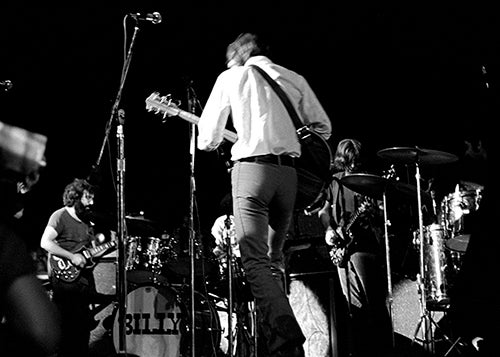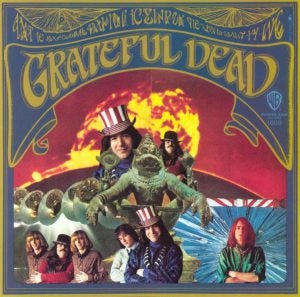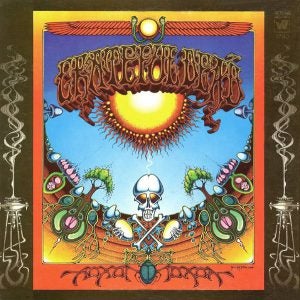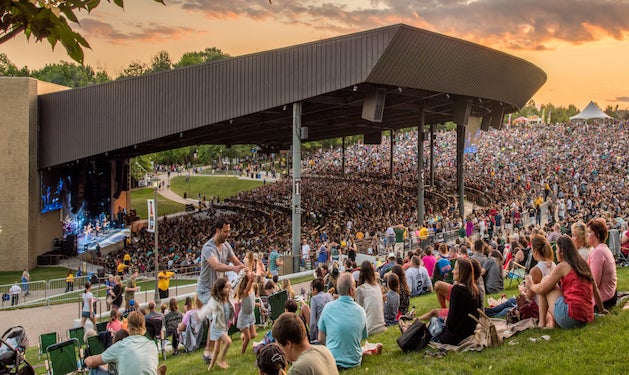As the premier live band and the quintessential jam band of the 1960s and beyond, the Grateful Dead sometimes had off nights. Their performance late Saturday night into Sunday morning at Woodstock was not considered one of their best, largely due to weather, sound equipment problems that caused long delays, and an almost completely dark stage.
Day Two, Performer 9: Grateful Dead
Performed Saturday night, August 16, 10:45 pm–Sunday morning, August 17, 12:30 am

Grateful Dead played an extended set on Saturday night at Woodstock. Left to right: Jerry Garcia, Bill Kreutzmann, Bob Weir, and Phil Lesh (out of frame: Ron "Pigpen" McKernan, Tom Constanten, and Mickey Hart). Photo © Doug Lenier.
Grateful Dead Band Members
- Jerry Garcia: guitar, vocals
- Bob Weir: guitar
- Ron "Pigpen" McKernan: keyboards, vocals
- Tom Constanten: keyboards, vocals
- Phil Lesh: bass
- Bill Kreutzmann: drums
- Mickey Hart: drums
Grateful Dead Woodstock Setlist
- Saint Stephen
- Mama Tried
- Dark Star
- High Time
- Turn on Your Lovelight
The Grateful Dead had its roots in a jug band by the name of Mother McCree’s Uptown Jug Champions, which was formed in Palo Alto, California in 1964 by local bluegrass guitar/banjo hot shot Jerry Garcia. The jug band’s lineup included a young guitarist and vocalist named Bob Weir and a powerhouse blues singer named Ron McKernan, whom Garcia christened “Pigpen.” After playing some coffeehouse gigs in and around the Palo Alto area, the band decided to play electric blues and rock, evolving into a group called The Warlocks with the addition of drummer Bill Kretuzmann and a classically-steeped bassist by the name of Phil Lesh. Within months of the formation of The Warlocks, the group changed their name to Grateful Dead and developed their improvisational, psychedelic/roots music while performing as the “house band” for Ken Kesey’s acid tests. They made a name for themselves playing dance concerts and benefits at Bill Graham’s Fillmore in San Francisco, Golden Gate Park, and other venues with San Francisco groups like Jefferson Airplane, Quicksilver Messenger Service, and Big Brother & The Holding Company, developing a dedicated fan base. Their jams often continued all night, with their psychedelicized audiences dancing for hours in trance-like states.
Using this as a springboard, the Dead began to amass a considerable following around San Francisco, playing a blend of pop, rock, and deep blues and forging a uniquely improvisational style that would become their calling card. This early approach was heard in full force on the first self-titled Grateful Dead album, released in March of 1967. Though the album made little notable impact outside of San Francisco, the band toured relentlessly throughout 1967 including an appearance at the Monterey International Pop Festival. Along the way, they picked up a second drummer, Mickey Hart, and avant-garde keyboardist Tom Constanten joined them in late 1968.

caused hardly a ripple beyond the San Francisco area.
The second Grateful Dead album, Anthem Of The Sun, was released in 1968. It took the band’s improvisational and experimental tendencies to greater extremes, and the band’s following grew by leaps and bounds. By 1969, the Dead were popular fixtures on the American touring circuit and they released their third album, Aoxomoxoa. The songs were cut down in length from those heard on Anthem Of The Sun, but the psychedelic experimentation was still in full force. By now the Dead had begun to amass a fanatical following (later known as “Deadheads”), and their popularity made them naturals for the Woodstock lineup.

two months before Woodstock and
is widely considered the Dead's experimental peak.
Before the Dead took to the Woodstock stage their sound engineer, the legendary LSD chemist Owsley “Bear” Stanley, had considered the Hanley PA system to be woefully inadequate for the band. In the course of making several alterations to the setup, he also removed the grounding from the electrical supply, ensuring that the PA that greeted the Dead when they finally took the stage was not only riddled with issues but potentially dangerous as well. The band members had also ingested a fairly large amount of LSD before going on and seemed quite lost onstage, a situation not helped by a multitude of similarly tripping freaks surrounding them on both sides of the stage.
Introduced by their friend Ken Babbs (one of Ken Kesey’s original Merry Pranksters, the group of acid-fueled crazies who emerged out of San Francisco in the mid-1960s), the band took off with “Saint Stephen,” a song from their new album, Aoxomoxoa. A major shock to rhythm guitarist Bob Weir (the result of touching his ungrounded microphone and guitar at the same time) blew the power out momentarily, ensuring that the second verse of the song was not captured by either the film or audio recording crews (who were running on the same circuit). Perhaps it was this shock that forced the band to abandon the song halfway through, ducking into a cover of Merle Haggard’s “Mama Tried” instead (although to be fair, the transition sounded pre-planned).
At this point, total confusion enveloped the stage when it became apparent that the PA system was not functioning correctly. Ken Babbs and various members of the Dead engaged in deeply stoned conversation on-mic for the next ten minutes until the issues were fixed enough for the group to continue. They ventured into a lengthy excursion into the psychedelic unknown with “Dark Star,” a song that had been released as a single the previous year and which was now a springboard for extended, spacy jamming. Unfortunately, it didn’t quite come together, sprinkling itself over the crowd without its usual intense peaks. The jam eventually petered out into a rendition of “High Time,” a Jerry Garcia ballad (written, as with most Garcia tunes, in collaboration with his longtime friend, lyricist Robert Hunter), as yet unrecorded by the band. It would be released the following year on the Workingman’s Dead album.
In desperate need of a lift, the group turned to their trusty bluesman vocalist Ron “Pigpen” McKernan, to deliver one of his patented rave-up versions of Bobby “Blue” Bland’s classic, “Turn On Your Lovelight.” Over the course of some 40 minutes, the band grooved mightily at times, with Pigpen attempting to provoke the crowd into getting up and dancing. The finale of the tune was actually quite rousing and brought the set to an end (without an encore). Despite disappointment from all sides, Grateful Dead at Woodstock was, at the very least, a qualified success in the face of much (mostly self-inflicted) adversity. Unfortunately, the band judged their performance to be a disaster, and the band declined to have any material from their set released on the Woodstock soundtrack album. Additionally, the stage lighting had been so poor during their set that what little film footage that was actually shot was all but unusable, meaning that their performance was not included in the Woodstock movie, nor on the soundtrack album.
The Grateful Dead, however, took Woodstock in stride and continued their “long, strange trip.” While they continued to release albums, they were more loved for their live performances. Their fans, called Dead Heads, would follow the band for entire tours, knowing that each night would be an entirely different show. The band encouraged their fans to record their live shows and freely trade them, creating a tremendous underground catalogue of live tapes for the ages. The band continued their grueling tour schedule, occasionally pausing for solo side projects, throughout the 1970s, ’80s, and ’90s until, in 1995, Jerry Garcia died of heart failure.
With his death, Grateful Dead ceased to be, but the other members of the band kept the legacy alive through various other projects. Guitarist Bob Weir founded the band RatDog and has been in other Grateful Dead spinoffs—The Other Ones, The Dead, and Furthur—for years. Bassist Phil Lesh formed a side project called Phil Lesh and Friends and was also part of The Other Ones, The Dead, and Furthur. Drummer Mickey Hart was also part of those three spinoffs and has worked as a solo artist, but his continuing work has been as a folklife historian and proponent of the healing power of music. The Grateful Dead’s other drummer, Bill Kreutzmann, was also involved with the spinoff groups and teamed up with Mickey Hart, Phish bassist Mike Gordon, and guitarist Steve Kimock to form The Rhythm Devils. His latest band is called Billy and the Kids. Keyboardist Tom Constanten left Grateful Dead in 1970 to pursue a career in academia. Keyboardist Ron “Pigpen” McKernan died in 1973 of a gastrointestinal hemorrhage.
—Wade Lawrence & Scott Parker
